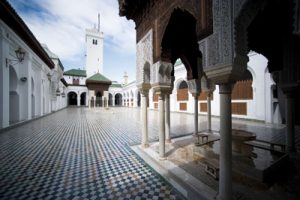Al Quaraouyine Mosque : Place of Cult and Sciences

In Islam, the mosque is a place of worship and learning and a space in which the conscience of collective belonging in its surroundings is crystalized. All these functions apply with distinction to al-Quaraouyine Mosque in Fez.
Associated with this mosque are several major events, one of which is the fact that it was built in the year 242 AH; that is, two years before the foundation of the city by less than five decades. The other fact is that it was built by a woman named Fatima al-Fihriya, the origin of whose family go back to Andalusia; her family is from Kairouan, Tunisia. Another fact is that it was expanded at the hands of the successive ruling dynasties in the history of Morocco, which is proof of the links that existed between religion, science and the Commandery of the Faithful. Established in it were academic chairs; and from it graduated many a cohort of religious scholars who supervised religiosity through their directives, religious knowledge, and the prominent role they played in allegiance.
In other Moroccan cities, there were mosques with al-Quaraouyine -style scientific chairs; a case in point is the Ibn Youssef Mosque in Marrakech, and it is to mosques of such caliber that students flock hailing from the various mosques that teach Qur’an and the fundamentals of religious sciences. These tributaries, along with al-Quaraouyine university, still constitute the body of religious traditional education which boasts a student population of more than 30,000 under the supervision of the Ministry of Religious Endowments and Islamic Affairs.
Al-Quaraouyine Mosque became a university early in time. It is said to be the oldest university in the world due to the multiplicity of arts that were taught in this institution in addition to religious sciences. Its scholars achieved prominence in other disciplines such as logic, astronomy and medicine. Its library, which is a treasure trove of manuscripts, bears witness to this fact. It also attests to the care and attention its students received from the kings of Morocco and to its architecture whose overhauling and restoration to its former function was cared for by the Commander of the Faithful, His Majesty King Mohammed VI.
In the context of reviving the role of al-Quaraouyine University and reforming its system, the Commander of the Faithful decided to include at its higher level six institutions. They are: al-Quaraouyine in Fez, the School of Islamic Sciences at the Hassan II Mosque in Casablanca and four institutions in Rabat: Dar El-Hadith El-Hassania, the Mohammed VI Institute for Qur’anic Readings and Studies, and the Mohammed VI Institute for the Training of Imams, Morchidines and Morchidates, and the Royal Institute for Research in the History of Morocco.
One of the university’s innovations befitting the glory of al-Quaraouyine is the order of His Majesty, the Commander of the Faithful, to create an educational specialization program at the level of al-Quaraouyine Mosque in Fez and the School of Islamic Sciences in Casablanca; this educational specialization is “The Highest Universality”. Enrolled in this specialization are high school degree students who have memorized the Holy Qur’an. They spend five years specializing in religious sciences with a curriculum that combines solid Sharia studies and linguistic studies in Arabic with basic approaches to human sciences, in addition to studying French and English; the purpose of which is to get them to a level wherein they are enable to receive a number of courses in them and to take written and oral exams. Students also study ancient languages such as Hebrew, Greek and Latin. This combination and structure is privileged in the world’s religious education programs.
